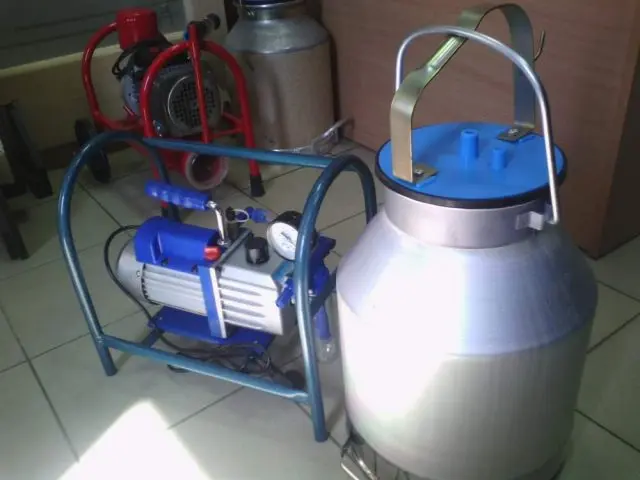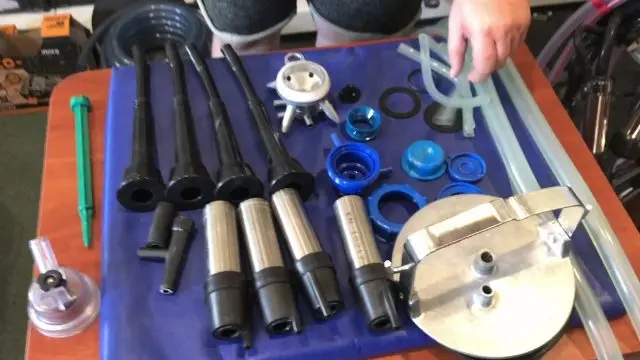Contents
When producing milk, it is necessary to flush the milking machine. The technique is in contact with the udder of the animal and the product. If you do not take care of regular sanitary and hygienic maintenance of the milking machine, then fungi and bacteria accumulate inside the device. Microorganisms are dangerous for both humans and cows.
Rules for the care of the milking machine
To keep the milking machine clean, you need to understand the features of hygiene procedures. Milk creates favorable conditions for the emergence and development of pathogenic colonies. Regular sanitization destroys the nutrient medium, destroys microorganisms, pollution.

For washing the milking machine, a separate room is allocated, located far from the place where the animals are kept. Sterility is maintained in a special washing department. At the end of each working day, the device is cleaned according to the algorithm:
- Dismantle. It is easier to wash the equipment in parts than in the assembled state.
- rinse. Milking cups are washed in a bucket with warm clean water, the unit is turned on. The liquid is pumped into the can. To change the flow of moisture, it is necessary to periodically lower and raise the elements.
- Washing solution. The alkaline preparation is diluted in boiling water, run through the technique several times. The rubber parts are carefully cleaned with a brush, the cover is processed from all sides.
- Get rid of household chemicals. Rinse several times in clean liquid.
- Drying. Spare parts are hung on a hook.
The daily procedure takes a minimum of time, while helping to keep the device clean. Once a week, a general washing of the milking machine is needed. The event will not only provide sanitary and hygienic maintenance of the unit, but also help to notice breakdowns in the early stages.
The process according to the algorithm is similar to the regular one, but the owner needs to disassemble all the nodes. Each part is soaked for 1 hour in a warm soapy liquid (alkaline or acidic). After the time has elapsed, the hoses and liner are thoroughly cleaned from the inside. Collector parts are washed, wiped with a dry cloth. Spare parts are rinsed several times in fresh water, allowed to drain and dry.
How to clean the milking machine
To keep the equipment in a sterile condition, you need to know the features of the sanitary and hygienic procedure. The first step is to get rid of the remnants of milk fat and liquid that accumulate on the parts. If you use cold water (below +20 C), then the frozen drops will harden, settle in a dense layer on the surface. So that dirt does not precipitate from boiling water, it is necessary to wash the milking machine at a temperature within safe limits (+ 35-40 C).
Hot solutions at +60°C quickly remove residues. Heavily contaminated areas of teat rubber are treated with a medium-sized brush. With the help of brushes of different diameters, it is easy to clean hard-to-reach areas. During washing of the milking machine, detergents dilute the milk fat, and alkalis corrode small inclusions. Chlorine-containing preparations disinfect the device.
Fill one container of the unit with warm liquid, and pour hot water (+55 C) into the second. Connect the device to a vacuum tap, drive off 5 liters of moisture, stop and shake the equipment. The procedure is repeated until the foam disappears. Each detail is treated with a brush.

After washing the milking machine, be sure to drain the remaining liquid. Small drops inside the unit will be an excellent environment for the development of fungi. Dangerous mold is not visible to the naked eye, but it negatively affects the health of people and animals. Spores will get on the udder and into the product, causing poisoning. To avoid trouble, you need to hang hoses, glasses on hooks in a warm place.
How to wash the milking machine at home
In dairy production, it is forbidden to use household chemicals for dishes. Fluids contain many harsh surfactants that are contraindicated for cows. The compounds gradually destroy the protective layer of the udder, provoke the appearance of irritations.
Baking soda can be used for daily washing of the milking machine. For 1 liter of water take 1 tbsp. l. funds. The resulting solution quickly cleans the walls of containers, hoses, gets rid of plaque and a specific smell. The substance destroys favorable conditions for the development of fungi and bacteria.
For disinfection of dairy equipment, concentrated Kompol-Shch Super is used. The agent with active chlorine for washing the milking machine does not form foam, so it is easy to wash out of containers, narrow parts. The chemical breaks down hard protein-fat deposits, kills pathogenic microflora. If you follow the rules of operation, it increases the resistance of alloys to corrosion. Circulation time – 10-15 minutes.
DAIRY PHO liquid acid agent is used to break up stubborn mineral and ferruginous deposits. Contains no hazardous phosphates or silicates. The drug does not damage steel and rubber parts of milk equipment. The working solution with improved cleaning properties does not form foam.
The chemical “DM Clean Super” is a complex washing liquid with a disinfecting effect. When washing the milking machine, the alkaline base easily destroys protein and fatty dirt on the equipment, prevents the appearance of hard deposits. The drug works great in both warm and cool water. If you observe the permissible concentration, it does not destroy the metal, rubber parts of the devices. A special additive prevents foaming, so it is easy to wash the residue.
Chlorine-containing “DM CID” is used for internal flushing of the milking machine. Washing and disinfecting concentrate destroys stubborn pollution of the protein nature, prevents the appearance of mineral deposits. The chemical bleaches polymer surfaces, contains substances that inhibit corrosion. Works in hard water in the temperature range +30-60 C.
Professional cleaners for washing the milking machine are often packaged in bulk packages, so they are not always available to small farms. Multifunctional cleaner “LOC” is produced in the form of a soft alkaline cream in 1 liter bottles. The chemical does not leave any foreign odor in containers, on hoses. The product will cope with the cleaning of any metal, plastic surfaces, does not cause corrosion. 5 ml of gel is enough for 50 liters of water.
Conclusion
Regular washing of the milking machine should become a habit. At the end of each working day, a standard cleaning of the equipment is carried out. Once a week, the equipment is carefully treated with special chemistry. Sanitary and hygienic care will not only get rid of fatty residues, but also destroy pathogenic bacteria and fungi. When choosing modern tools, they prefer options marked “For dairy production”.









